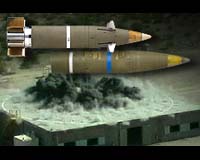| . |  |
. |
Tel Aviv, Israel (UPI) Jul 7, 2009 Israel is developing a new "smart" glide bomb, a weapon that had its origins as far as back as World War I. It is likely to wind up in the Israel armory for operations against Palestinian militants and Lebanon's Hezbollah guerrillas. The weapon, designated the Medium Laser-Guided Bomb, is still in the early stages of development by the state-run Israel Aerospace Industries, flagship of Israel's defense industry. The bomb, on display for the first time at the recent Paris Air Show, was described as a "precision weapon for precision attacks or close air support against various types of targets such as buildings, small bunkers, time-critical targets and moving targets," offering "pinpoint accuracy for all-weather conditions" as well as trajectory control." Glide bombs are aerodynamically configured to flatten and extend their normal flight trajectory and can be controlled from the launch aircraft for pinpoint attacks. The Israeli air force frequently targets militants while they are moving around in vehicles. The weapons employed in such cases range from air-to-ground missiles fired from F-16 strike aircraft or helicopter gunships. Other targets that might be suitable for the glide bomb are makeshift factories manufacturing homemade Qassam rockets used by Hamas to fire into Israel. The militants are extending the range and firepower of these projectiles launched from Gaza to the point where they may soon target urban areas around Tel Aviv in central Israel. The glide bomb is said to carry a 36-pound warhead and appears to be about the same size as the U.S. GBU-39/B Small Diameter Bomb. The German Luftwaffe held flight trials with a German precision-guided Hope standoff penetrator glide bomb. The results remain closely guarded, but Aviation Week reported on Sept. 25, 2008, that the weapon, using a GPS guidance system aided by an inertial navigation system, hit its targets precisely. The bomb was launched from a Luftwaffe Tornado IDS strike aircraft at the flight test center at Vidsel in Sweden. During World War I, Wilhelm von Siemens proposed a "torpedo glider" -- a wire-guided missile that was basically a naval torpedo with an airframe attached -- but the conflict ended before it could be developed. But during World War II, the Germans introduced the first operational glider bombs, primarily as anti-shipping weapons as von Siemens had envisaged. These were radio-controlled weapons designated Ruhrstahl SD 1400 and generally known as Fritz-X. On Nov. 26, 1943, the British troopship Rohna was sunk by one of these weapons as it carried U.S. troops from Oran, Morocco, to Port Said, Egypt, in an allied convoy traversing the Mediterranean. The bomb ripped a huge hole in the ship's port side and set the vessel on fire. It sank and 1,235 soldiers and crewmen perished. The attack with this mysterious weapon was hushed up for many years, but it inflicted the highest U.S. death toll of any ship sunk in World War II. After the war, the Americans developed the glide bomb, adding sophisticated electronics. These evolved in the 1960s into the U.S. Air Force's AGM-62 Walleye and later the AGM-65 Maverick. Share This Article With Planet Earth
Related Links The latest in Military Technology for the 21st century at SpaceWar.com
 Excalibur Ib Demonstrates Accuracy During First Guided-Flight Tests
Excalibur Ib Demonstrates Accuracy During First Guided-Flight TestsYuma Proving Ground AZ (SPX) Jul 07, 2009 Raytheon fired two precision-guided projectiles from a Paladin gun system during the first guided flight test of the Raytheon Excalibur Ib program. The Excalibur Ib is a precision-guided artillery projectile based on Raytheon's combat-proven Excalibur 1a. The tests demonstrated how the new base design, changes to the Excalibur Ia warhead, fuzing and control actuation system work together ... read more |
|
| The content herein, unless otherwise known to be public domain, are Copyright 1995-2009 - SpaceDaily. AFP and UPI Wire Stories are copyright Agence France-Presse and United Press International. ESA Portal Reports are copyright European Space Agency. All NASA sourced material is public domain. Additional copyrights may apply in whole or part to other bona fide parties. Advertising does not imply endorsement,agreement or approval of any opinions, statements or information provided by SpaceDaily on any Web page published or hosted by SpaceDaily. Privacy Statement |